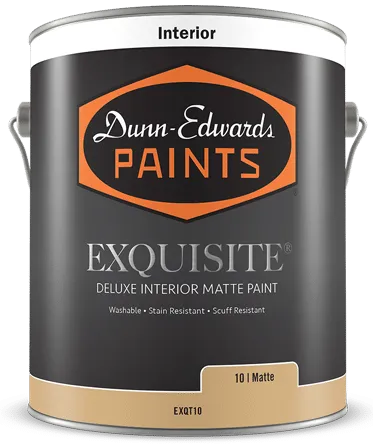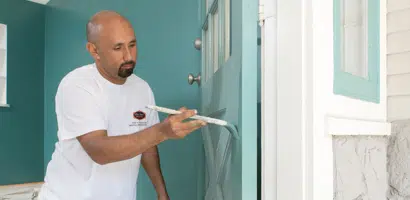Painting a Room
Professional painter Cole Schaefer shows you the proper way to paint a room, from determining what painting supplies you'll need to how to use a brush and roller.
View Transcript
| Video/Text on-screen | Copy |
|---|---|
| Opening- Dunn-Edwards logo | [Music] |
| Man talking | Hi. I'm Cole Schaefer, professional painter, and welcome to Dunn-Edwards paints “how-to paint” video series. You know nothing in the world breathes life into your home like a fresh coat of paint, in this video I'll show you the proper way to paint a room, from determining what painting supplies you'll need, to how to use a brush and roller. We'll even show you tips for getting the job done right the first time. Now before you paint, remember preparation is the key to a good paint job, if the prep work is done right then the painting is easy. So, to get an idea on how to prep the surface you will be painting see our prepping a room for painting video on dunnedwards.com/videos. So, onto painting, well first you'll need to pick up some painting supplies. You'll need a canvas drop cloth to create a work area for getting your paint and painting tools ready, a two and a half inch angular trim brush for trimming in around corners, windows, doors and moldings, and the roller cover handle and tray for painting. Use a half inch or higher cover with lower gloss paints or a shorter roller for higher gloss paints. Oh, and don't forget an extension pole to reach higher areas especially if you have ceilings over eight feet tall, and you also need a trim bucket to use if you're painting with a brush, also a two gallon bucket to mix paint in and some stir sticks. Now you'll want to mix multiple gallons of paint together to ensure your paint has consistent color, and make sure you have a stepladder to reach those high areas, and some wiping cloths to clean up any spills that may occur. I also like to keep a five in one tool handy. |
| Paint can clip | And of course, you've got to have your Dunn-Edwards premium interior paint. |
| Wetting paint brush | Start by pre-wetting your brush or roller before painting, this improves their ability to pick up and release paint easier. Next, pour your paint into your trim bucket. Now to make cleanup easier reuse the two gallon bucket. |
| Man talking | You use for mixing your paint as your trim bucket, put just enough paint in the bucket to cover about a third of paint bristles. |
| Prepping paint | Then, pour your paint into your paint tray, put your roller slowly into the tray rolling it back and forth until the roller is covered evenly. |
| Man talking | Before we start painting let's quickly go over some tips for using a brush and roller. Hold the brush near the base of the handle and dip the bristles a third of the way into the paint, tap, don't wipe. I like to use the inside walls of the bucket to tap against to ensure the brush scoops up the most amount of paint, that saves you time because you'll get more out of each dip into the bucket when brushing. |
| Brushing | Paint a two inch wide strip around ceilings floors and doors, paint with enough pressure to bend the bristles slightly but don't bear down too hard as the brush will leave unsightly brush marks. Now let's go over some tips with rolling. First attach an extension pole to the roller handle, the extension pole isn't just for reaching high places it will also help you paint the wall space faster and it really saves your back. Now when you start rolling, cover about a 2 square foot area using an end pattern rolling up first to minimize dripping, then work your way back to the previously painted area making sure you apply the paint evenly and get good coverage. |
| Man talking | Now remember not to go too fast, going at a slower speed gives you better coverage and limits paint splatter. Now you're ready to paint. Best practice is to paint one wall at a time. Start by cutting in the corners and around the ceilings of the wall, then cut in any windows and doors. Once you've painted everything, grab your roller cover and load it with paint. Start at a corner and begin applying paint using the end pattern roll over as much of the brushed areas as possible, also roll as close as you can get to ceilings and floors without touching them. Once you've completed one wall move on to the next. Why paint one wall at a time? Well you want to do that to prevent what the pros call “picture framing”, this problem occurs when you cut in an entire room with a brush and then the paint dries before you start rolling. The roller texture will not match the smoother application of your brush and your walls will look, well, they look like they're framed. After the entire room is painted grab your brush, go back and cut in around the floor and baseboards, there are less worries about picture framing along the floor because it's difficult to see any problems at floor level. Well after the entire room is painted, the results, they'll look amazing and you'll have a paint job you can be very proud of. If you have any more questions or need additional help, please visit your neighborhood Dunn-Edwards paint store. For all of us here at Dunn-Edwards paints, I'm Cole Schaefer. Thanks for watching and happy painting. |
| Closing- Dunn-Edwards logo | [Music] |






